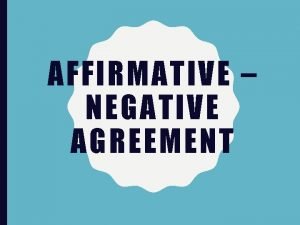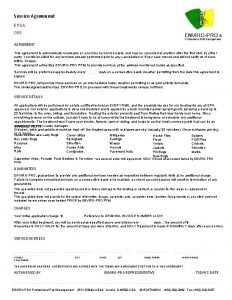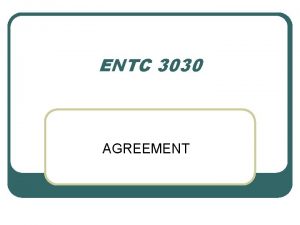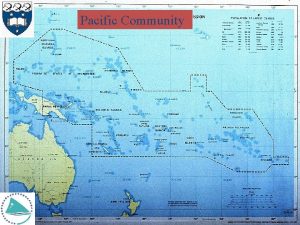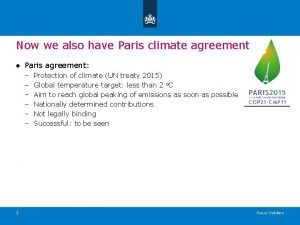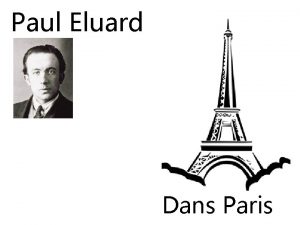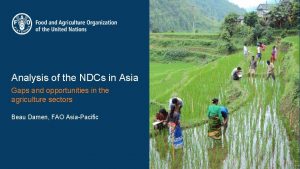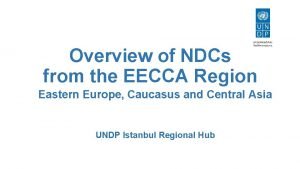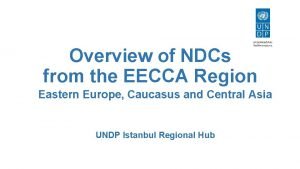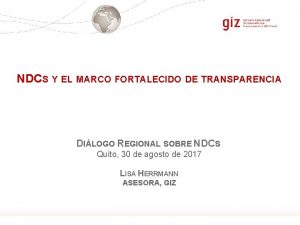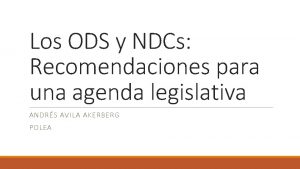The Paris Agreement and Pacific NDCs Presentation to









































- Slides: 41

The Paris Agreement and Pacific NDCs Presentation to REGIONAL WORKSHOP ON ENERGY EFFICIENCY IN MARITIME TRANSPORT Port Vila, Vanuatu, 12 -14 December 2016 Dr Peter Nuttall Sustainable Sea Transport Research Programme The University of the South Pacific

The Paris Agreement and Pacific NDCs The Paris Agreement December 2015 agreed target to limit global warming to “well below 2 C” from preindustrial levels and “pursue efforts” to stay within 1. 5 C. Global agreement joined by most states • Replaces Kyoto Agreement • Underpinned by “NDC”s – country level commitments to reduce emissions • Silent on Bunkers This leaves considerable leeway but also places considerable responsibility on IMO and ICAO to demonstrate leadership MEPC 70 agreed a road map for IMO work on climate change and ship emissions with 2018 and 2023 milestones

The Paris Agreement and Pacific NDCs The Paris Agreement December 2015 agreed target to limit global warming to “well below 2 C” from preindustrial levels and “pursue efforts” to stay within 1. 5 C. “The Paris Agreement cannot be stopped as the global energy transition cannot be stopped. The world is forging ahead, and the smart money is on clean energy. Who would be against this unstoppable global trend? Who would like to be left behind? ” Miguel Arias Cañete, Spanish Head of the European Commission, Marrakesh

The Paris Agreement and Pacific NDCs How are shipping Emissions related to the emissions related to Paris Agreement? If shipping is to contribute to PA then full understanding of shipping's emissions science is needed!

Low carbon shipping past, present, future Tristan Smith 20/11/2016

Past 6

Second IMO GHG Study (consensus activity-based) 7

Second IMO GHG Study (consensus activity-based) 2007 -2012 Third IMO GHG Study 8

Present 9

Shipping, the ‘greenest’ mode of transport? 10000 Bulk carrier Chemical tanker Container General cargo Liquefied gas tanker Oil tanker Refrigerated bulk Air Road Rail (diesel) EEOI in g. CO 2 per t. km 1000 10 1 1 10 1000 Average payload tonnes 10000 10 1000000

Shipping, the ‘greenest’ mode of transport? 10000 EEOI in g. CO 2 per t. km Aviation 1000 Road 100 Shipping Rail 10 1 1 10 10000 Average payload tonnes 11 1000000

Current regulation

Future 13

CO 2 budget and MBM start year Opt. 1 - Responsibility principle, 1. 5 degrees, 18 Gt (2025) 1200 million of CO 2 1000 Opt. 2 - Responsibility principle, 2 degrees, 33 Gt (2025) 800 Opt. 3 - Responsibility principle, 2 degrees, 33 Gt (2030) 600 Opt. 4 - Egalitarian principle, developed country based, 23 Gt (2025) 400 Opt. 5 - Egalitarian principle, developing country based 79 Gt (2025) 200 0 2015 2020 2025 2030 2035 2040 2045 2050 Carbon budget: 18, 23, 33, 79 GT Start year

Transport Demand SSP 3 RCP 2. 6 Source: Third IMO GHG Study 15

Typical length of contract (charter) All scenarios here are 2 degree Average economic lifespan of ships today Max period for financing 60 -90% decrease in fleet average carbon intensity

What is the potential EEOI (carbon intensity) reduction for a ship Operating speed 2008 spec Max spec wind + 50% Max spec fuel carbon (no wind) wind factor reduction Yellow = 30 -70% of 2008 baseline EEOI Green < 30% of 2008 baseline EEOI Max spec wind + 75% fuel carbon factor reduction

Fuel mix for each scenario

Fuel mix for each scenario BAU Significant increase 1. 5

Transport demand sensitivity

2050 • Its about sending signals to the market. Taking car makers as an example, Jochen Flasbarth said: “If you would go for a 30 -40% greenhouse gas cut in the transport sector, you could go to biofuels and more efficient engines to meet the targets. But if you want to meet the Paris targets, it will not be enough. It is important to invest in the right technologies. ” • “You skate to where the puck is going to be, not to where the puck has been. ” Catherine Mc. Kenna

Private Transparency and operational CO 2 metrics IMO EU Zero carbon ships and infrastructure Ferries and demonstrators 1 MW 5 MW ‘Incentive’ million of CO 2 Deep sea newbuilds Short sea newbuilds $30 40 MW $100 $200 1000 900 800 700 600 500 400 300 200 100 0 Opt. 2 - Responsibilit y principle, 2 degrees, 33 Gt (2025) 2010 2015 2020 2025 2030 2035 2040 2045 22 2050

Summary • ‘Greener’ risks getting the wrong answer (LNG, stranded assets) • Regional innovation niches • Trade, transport demand, shipping • Transparency, tracking, timescales and investment risk • Value/mechanisms for reduction now – budget approach 23

Summary • ‘Greener’ risks getting the wrong answer (LNG, stranded assets) • Regional innovation niches • Trade, transport demand, shipping • Transparency, tracking, timescales and investment risk • Value/mechanisms for reduction now – budget approach 24

Sustainable Shipping: Anchored or adrift in the Pacific’s emission targets? Photo courtesy: Derick PACE-SD Seminar Series | Thursday 19 May 2016 Avnita Goundar Ph. D Candidate, Sustainable Sea Transport Research Programme Pacific Centre for Environment and Sustainable Development The University of the South Pacific, Suva, Fiji

Pacific’s commitment to reducing greenhouse emissions • The contribution of PICs to global greenhouse emissions is negligible, accounting for ~0. 03% of the global emissions of CO 2 from fuel combustion. • Against this background and the fact that they are all Small Island Developing States, PICs were not compelled to set ambitious emission reduction targets under the Paris Agreement but they have done so. • Demonstrates solid commitment of a region that is already experiencing the devastating effects of climate change, and facing the threat of loss of cultures and countries.

What is the relevance of PSIDS NDC’s • INDCs will become Nationally Determined Contributions (NDCs) once a country ratifies the Paris Agreement. • NDC’s define the moral high ground available to PSIDS in UNFCCC processes and IMO and ICAO. • NDC’s define the highest level policy signal for allocation and legitimacy of climate financing. • PSIDS progress toward meeting their NDC non-conditional target must reported in 4 years from ratification. Progress will likely be the basis for future allocations of GCF. • The following analysis suggests the PSIDS collectively have misrepresented the true NDC target potential available. • This is likely to have serious consequences to Pacific transport sector for accessing future climate financing potentials.

INDC commitments of Pacific countries 120 PICs INDC emission reduction targets 80 43 70 32 * electricity target Conditional commitment ** electricity and transport target at u ** * Va nu Tu va lu ** ** a* ng To om on Is ** oa * Sa m ** So l Unconditional commitment * 30 22 RM I* * ru Na u * i* at i* Fij Ki rib FS M ** 0 ok Is * 12. 8 10 38 G* 28 PN 20 38 100 60 la u* ** 20 45 100 13 * 49 ue 40 100 Ni 35 Non-GHG reduction 42 Pa 60 Co % of emission reduction 100 *** electricity, transport and others target

Sectors targeted by Pacific countries in INDCs Palau Tuvalu Marshall Is Tonga Vanuatu Electricity, transport and others 36% FSM Electricity Kiribatiand transport Solomon Is 21% Electricity 43% Cook Is Fiji Nauru Niue PNG Samoa

Key issues in PIC INDCs • Difficult to compare as they are not measured in the same way: – Different baseline years for GHG emissions (ranging from 2000 to 2010 to no data). – Different sectors covered (electricity, electricity/transport, all sectors) – Different target years (from 2020, 2025 to 2030) and some PICs chose to keep targets for two different years. – Conditional and unconditional commitments vary • Major data gaps are obvious in almost all PIC INDCs: – Sectoral and sub-sectoral GHG emissions data for missing in some – External funding required to fulfil conditional pledges missing in some – reliability of data highly questionable in some cases.

As of 11 February 2016, 161 countries, including 14 Pacific Islands countries, ha submitted their Intended Nationally Determined Contributions (INDCs) to UNFCCC. Where does shipping fall in the Pacific’s emission targets?

Sea transport features in the INDC targets for one PIC RMI estimates that in order to achieve its overall INDC target for 2030, emissions from its transport sector (including land shipping emissions) have to decrease by 16% in 2025 and by 27% in 2030.

The domestic shipping sector’s contribution to GHG emissions is known for two PICs only 10% 1%

Transport sector features in the INDC target sectors of eight PICs Only PIC to set a target for transport sector - 16% in 2025 and by 27% in 2030.

Country Cook Is FSM Fiji Kiribati Nauru Niue Palau PNG RMI Samoa Solomon Is Tonga Tuvalu Vanuatu Inclusion of transport sector in INDCs Inclusion in INDC target % reduction by 2025 % reduction by 2030 no n/a yes no data n/a n/a no no data n/a no n/a yes no no data n/a yes 16% 27% no n/a yes no data no data no yes

The energy sector is the largest emitter of GHG. In 6 out of 14 PICs, the transport sector is a larger emitter than electricity

Comparative sectoral GHG emissions of PICs (compiled from PICs INDC reports, 2015). No bars indicate no data in INDC report.

Country Contribution of transport emissions Overall (%) Cook Is FSM Fiji Kiribati Nauru Niue Palau PNG RMI Samoa Solomon Is Tonga Tuvalu Vanuatu Sub-sector emissions Land Air Sea 42% 33% 8% 1% 38% no data 52% no data 57% no data 12% no data 61% 40% no data 28% no data no data 27% no data 40% no data no data no data no data 10% no data no data no data

Reflections • Low carbon shipping continues to be viewed as a ‘high hanging fruit’ and is still not a priority in regional and national development agendas when compared to electricity generation. • PIC INDCs, as currently presented, are not adequately powered to drive transition to low carbon shipping in the Pacific region. • Urgent need for development of more robust data collection methods and data analysis for determining appropriate sectoral emission reduction targets in INDCs. • Further research required to assess level of investments and current efforts in strengthening/improving transport data collection and repositories at national and regional levels.

Reflections • Revision of initial INDCs – Absence of relevant information in initial preparation disadvantaged developing countries – Can be revised if conditions change and more information is available on actual needs and resources required. – Timeframe for next revision can be between December 2015 (after COP 21) and 2020 – however, countries have the option of implementing their current INDCs as NDCs from 2020 and then revise to submit a new NDC in 2025.

Photo courtesy: www. muavoyage. com Thank you!
 Positive and negative agreement
Positive and negative agreement Garbage patch
Garbage patch Sinciput presentation
Sinciput presentation Vertex presentation
Vertex presentation Hát kết hợp bộ gõ cơ thể
Hát kết hợp bộ gõ cơ thể Slidetodoc
Slidetodoc Bổ thể
Bổ thể Tỉ lệ cơ thể trẻ em
Tỉ lệ cơ thể trẻ em Chó sói
Chó sói Tư thế worm breton là gì
Tư thế worm breton là gì Hát lên người ơi alleluia
Hát lên người ơi alleluia Các môn thể thao bắt đầu bằng tiếng bóng
Các môn thể thao bắt đầu bằng tiếng bóng Thế nào là hệ số cao nhất
Thế nào là hệ số cao nhất Các châu lục và đại dương trên thế giới
Các châu lục và đại dương trên thế giới Công thức tính độ biến thiên đông lượng
Công thức tính độ biến thiên đông lượng Trời xanh đây là của chúng ta thể thơ
Trời xanh đây là của chúng ta thể thơ Mật thư tọa độ 5x5
Mật thư tọa độ 5x5 101012 bằng
101012 bằng Phản ứng thế ankan
Phản ứng thế ankan Các châu lục và đại dương trên thế giới
Các châu lục và đại dương trên thế giới Thể thơ truyền thống
Thể thơ truyền thống Quá trình desamine hóa có thể tạo ra
Quá trình desamine hóa có thể tạo ra Một số thể thơ truyền thống
Một số thể thơ truyền thống Bàn tay mà dây bẩn
Bàn tay mà dây bẩn Vẽ hình chiếu vuông góc của vật thể sau
Vẽ hình chiếu vuông góc của vật thể sau Biện pháp chống mỏi cơ
Biện pháp chống mỏi cơ đặc điểm cơ thể của người tối cổ
đặc điểm cơ thể của người tối cổ V cc
V cc Vẽ hình chiếu đứng bằng cạnh của vật thể
Vẽ hình chiếu đứng bằng cạnh của vật thể Vẽ hình chiếu vuông góc của vật thể sau
Vẽ hình chiếu vuông góc của vật thể sau Thẻ vin
Thẻ vin đại từ thay thế
đại từ thay thế điện thế nghỉ
điện thế nghỉ Tư thế ngồi viết
Tư thế ngồi viết Diễn thế sinh thái là
Diễn thế sinh thái là Dot
Dot Số nguyên tố là số gì
Số nguyên tố là số gì Tư thế ngồi viết
Tư thế ngồi viết Lời thề hippocrates
Lời thề hippocrates Thiếu nhi thế giới liên hoan
Thiếu nhi thế giới liên hoan ưu thế lai là gì
ưu thế lai là gì Khi nào hổ mẹ dạy hổ con săn mồi
Khi nào hổ mẹ dạy hổ con săn mồi
